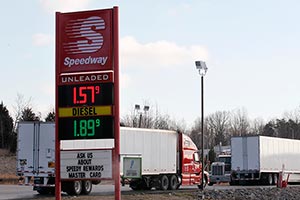Senior Reporter
Diesel Prices Fall 6.5¢ to $2.112

The U.S. average retail diesel price fell for the 10th consecutive week, down 6.5 cents a gallon to $2.112, leaving it at the lowest price since March 23, 2009, the Department of Energy reported Jan. 19.
Trucking’s main fuel was 82.1 cents a gallon cheaper than a year ago, when it was $2.933, DOE’s Energy Information Administration said.
Diesel fell in all regions, and its lowest price was in the Gulf Coast, where it dropped 6.6 cents to $2.014.
The average retail price of gasoline fell to $1.914, down 8.2 cents from Jan. 11, and 15.2 cents cheaper than a year ago when it was $2.066. Gasoline was down in all regions, and lowest along the Gulf Coast, where it dropped 5.5 cents to $1.672.
Denton Cinquegrana, an analyst with the Oil Price Information Service, told Transport Topics the average retail diesel price Jan. 19 was lower than the average retail gasoline price in Alaska, California and Montana — and the two were even in Nevada, according to AAA’s Daily Fuel Gauge Report.
“I think you’re going to see more and more of that happening, particularly in the spring and summer [when demand for gasoline goes up],” Cinquegrana said.
U.S. average #Diesel fuel price on 1/18/16= $2.112/gal, DOWN $0.065 from week ago https://t.co/MYXeN58LV4 #truckers pic.twitter.com/o2KN63jSbU — EIA (@EIAgov) January 19, 2016
Meanwhile, crude oil futures closed on the New York Mercantile Exchange at $28.46 a barrel Jan. 19. It was the lowest close since September 2003. The last close below $30 a barrel on Nymex was $29.95 on Dec. 1, 2004.
Bloomberg News reported global oil markets could “drown in oversupply,” sending prices lower as demand growth slows and Iran revives exports with the end of sanctions, according to the International Energy Agency.
IEA trimmed 2016 estimates for global oil demand as China’s economic expansion weakens and raised forecasts for supplies outside the Organization of Petroleum Exporting Countries, Bloomberg said.
While non-OPEC supply is set to drop 600,000 barrels a day in 2016, Iran’s comeback could fill that gap by the middle of the year, Bloomberg said. As a result, world markets may be left with a surplus of 1.5 million barrels a day in the first half.




